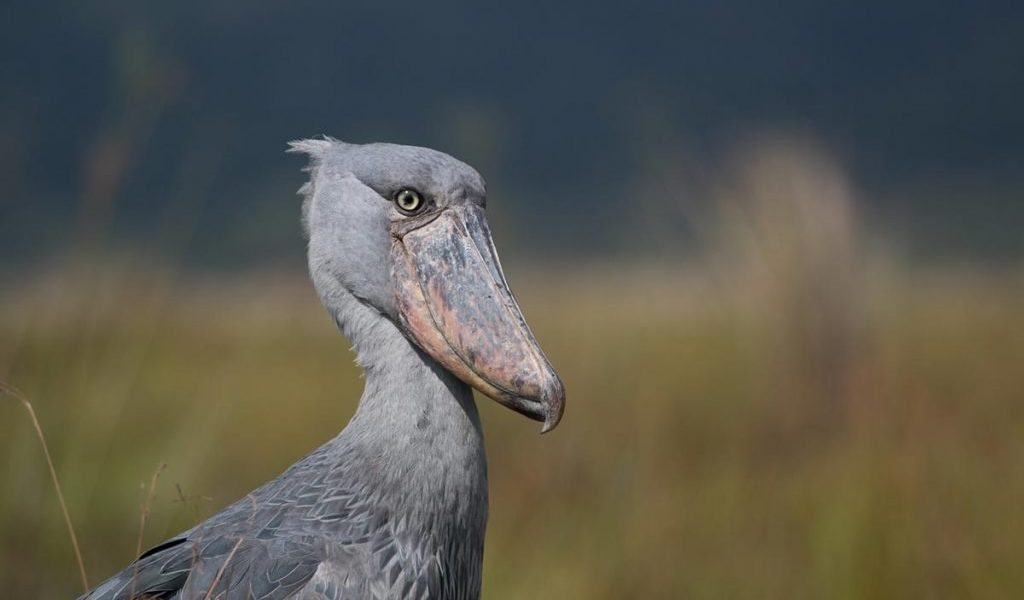Shoebill Tracking In Uganda can be done in nine (09) different locations within Uganda.
The Top Nine (09) Places to see Shoebills in Uganda Include:
- Murchison Falls National Park.
- Mabamba Swamp on Lake Victoria
- Lake Mburo National Park.
- Toro-Semuliki Game Reserve.
- Makanaga Swamp.
- Lwera Swamp along Masaka road.
- Ishasha Sector (Queen Elizabeth National Park).
- Lugogo Swamp (Zziwa Rhino Sanctuary).
- Uganda Wildlife Education Centre in Entebbe
Even for those not so interested in Birds, spotting the shoebill while on safari in Uganda makes for a memorable experience.
The shoebill is an elusive prehistoric bird whose history traces back to the dinosaur times. The shoebill has for a long time been mislabeled as a stork until recently when it was reclassified as a Pelican. Shoebills lay eggs similar to pelicans and also share DNA similarities with the pelicans.
The shoebill usually comes in between 40 and 50 inches, although it may be slightly larger than this depending on the individual bird. Male shoebill birds usually weigh around 12 pounds (±5 Kg) and are a little bit heavier than female shoebills, but not by much. All shoebill birds have massive shoe-like bills and feature grey plumage that is brown when they’re younger. They have a large wingspan meant for soaring and short necks, unlike their stork and pelican relatives. Although their body and wings are shaped somewhat like a condor, shoebills are not related to this type of bird.
Shoebills use their massive, powerful shoe-like bill to kill and eat their prey, which is usually fish. They may also eat some rodents as well as turtles and smaller birds, but this is not very common. Shoebills clatter their bills to communicate with one another, but may also rarely make mooing sounds like a form of communication as well.
The Top Nine (09) Shoebill tracking Locations In Uganda
Shoebill Tracking In Murchison Falls National Park is done at the Delta area – a spot where the Nile divides into Lake Albert and the Albert Nile – which continues further north through Sudan into the Mediterranean sea.
While the delta area is popular for shoebill Tracking, it is also home to a variety of other beautiful Ugandan birds. Shoebill Tracking in Murchison Falls National Park is best done on a boat Safari down Stream. Alternatively, one can opt to take the boat trip one way to track the shoebill, and later join a guide on a game drive through the savannah plains of the gigantic Murchison Falls National Park.
** Taking a boat safari (one way) requires proper planning. A packed lunch is recommended, and your guide must be informed to wait for you at the delta area. If booked with Realm Africa Safaris, we take care of all this!
Read More about Shoebill Tracking In Murchison Falls National Park.
Browse all our Murchison Falls Safaris
Seated on the mighty Lake Victoria – the world’s second-largest lake after Lake Superior, Mabamba Swamp is home to the vulnerable shoebill Stork. Mabamba Swamp is easily accessed from Entebbe using a traditional motorised canoe. Although shoebill tracking in Mabamba swamp can be done both in the morning and afternoon, we have a preference for tracking In the morning when the temperatures are cool. The best time to track the shoebill in Mabamba Swamp is in the dry season from January-March
Read More about Shoebill tracking in Mabamba Swamp
See Our 01 Day Shoebill Tour into Mabamba Swamp
Located approximately 4 hours from Kampala, Lake Mburo National Park is another interesting park to visit for people seeking to see the rare shoebill Stork In Uganda.
Read More about shoebill tracking In Lake Mburo National Park.
See our 03 Days Lake Mburo Safari including shoebill tracking
- Toro-Semuliki Reserve
Toro-Semuliki game reserve is Uganda’s bird sanctuary with well Over 400 bird species including the shoebill stork. The park is located in Southwestern Uganda and can be accessed from Fort Portal Town.
The Best time to visit the Toro-Semuliki reserve for birdwatching is March, just after the relatively dry season from December to February. This time is also the breeding time for most bird species.
Read More about Shoebill Tracking in the Toro-Semuliki reserve
See All Our Birding Safaris In Uganda
Makanaga Swamp is a good place to spot shoebills. It’s roughly a 60km drive from Entebbe, accessed via Kampala–Masaka Rd, taking the road down from Kamengo trading centre. Makanaga is less visited compared to Mabamba Swamp. This, therefore, makes Makanaga the best place to visit for very Intent birders who love to go to less crowded sites.
Lwera Swamp
Lwera Swamp en route to the western part of Uganda; Queen Elizabeth NP, Bwindi Forest NP & Lake Mburo National Park – is a good place to spot the shoebill. Although the chances here are slim, the sighting is getting very common these days. Your guide will often stop to speak to a few fellow guides or local folks to find out if there have been any Sightings.
- Ishasha Sector ( Queen Elizabeth NP)
Though popular for the tree climbing Lions, the Ishasha sector of Queen Elizabeth NP has more to offer. Travellers can indulge in Shoebill tracking along the Marsh-filled Lake Edward shores. Besides tracking down the elusive shoebill stork, one can enjoy “remote” game-viewing experiences as this part Of the park is often skipped by Many tour operators. We love to take our clients to authentic places like Ishasha.
Things to see & do In Ishasha Sector of Queen Elizabeth NP
Accessible through the Zziwa Rhino Sanctuary, the Lugogo swamp is among the top 09 places to indulge in Shoebill tracking In Uganda.
A visit to Lugogo Swamp for shoebill tracking can easily be combined with Rhino Tracking at Zziwa, Chimpanzee tracking in Budongo Forest, Shoebill tracking In Murchison Falls, a boat safari to the falls and a game viewing safari in Murchison Falls National Park.
Read more about Shoebill tracking In Lugogo Swamp Inside Zziwa Rhino Sanctuary.
See Our 4-Day Murchison Falls Safari
Previously known as Entebbe Zoo, the present-day Uganda Wildlife Education Centre is a rehabilitation centre for rescued animals recovered from poachers and traffickers. Among these living onsite is the rare shoebill.
The shoebill at UWEC is fairly tame and is very welcoming to her guests – the kids love to visit the shoebill exhibit.
For adults, a visit to the UWEC (zoo) will give you a proper insight into what Uganda has to offer in regard to wildlife. You Can also Indulge in our favourite “Behind-the-scenes experience“
We hope the information provided above has been beneficial to you. For any more information regarding shoebill tracking In Uganda, you now know who to Ask! _ Realm Africa Safaris™
[/checklist][/vc_column][/vc_row]


